For the 2025 school year, there are 2 public middle schools serving 284 students in Clay County School District. This district's average middle testing ranking is 4/10, which is in the bottom 50% of public middle schools in Alabama.
Public Middle Schools in Clay County School District have an average math proficiency score of 9% (versus the Alabama public middle school average of 21%), and reading proficiency score of 42% (versus the 46% statewide average).
Minority enrollment is 36% of the student body (majority Black), which is less than the Alabama public middle school average of 45% (majority Black).
Overview
This School District
This State (AL)
# Schools
5 Schools
534 Schools
# Students
1,776 Students
236,737 Students
# Teachers
106 Teachers
12,843 Teachers
Student : Teacher Ratio
17:1
17:1
District Rank
Clay County School District, which is ranked within the bottom 50% of all 145 school districts in Alabama (based off of combined math and reading proficiency testing data) for the 2021-2022 school year.
The school district's graduation rate of 80-84% has decreased from 90-94% over five school years.
Overall District Rank
#82 out of 145 school districts
(Bottom 50%)
(Bottom 50%)

Math Test Scores (% Proficient)
22%
29%
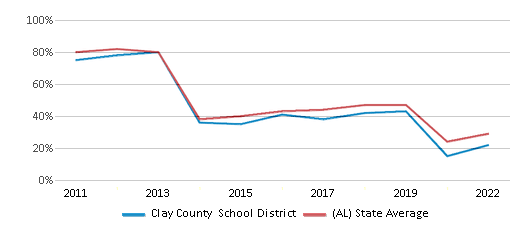
Reading/Language Arts Test Scores (% Proficient)
42%
47%
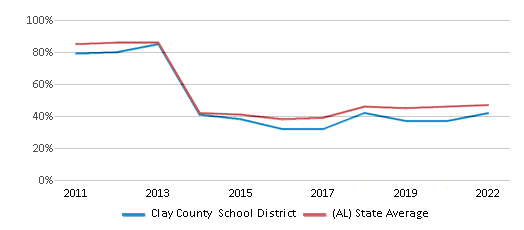
Science Test Scores (% Proficient)
33%
38%
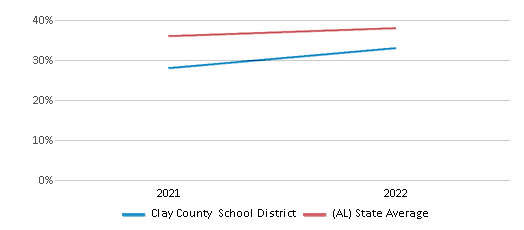
Graduation Rate
80-84%
88%
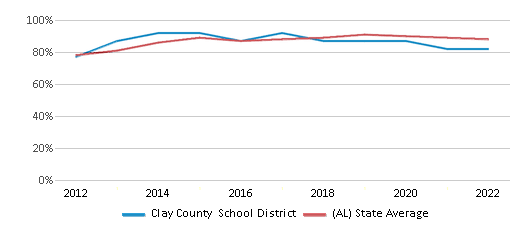
Students by Ethnicity:
Diversity Score
0.49
0.61
# American Indian Students
3 Students
3,329 Students
% American Indian Students
n/a
2%
# Asian Students
4 Students
2,720 Students
% Asian Students
n/a
1%
# Hispanic Students
105 Students
24,370 Students
% Hispanic Students
6%
10%
# Black Students
310 Students
68,686 Students
% Black Students
18%
29%
# White Students
1,224 Students
129,762 Students
% White Students
69%
55%
# Hawaiian Students
1 Student
257 Students
% Hawaiian Students
n/a
n/a
# Two or more races Students
129 Students
7,613 Students
% of Two or more races Students
7%
3%
Students by Grade:
# Students in PK Grade:
-
2,540
# Students in K Grade:
155
5,092
# Students in 1st Grade:
153
5,246
# Students in 2nd Grade:
131
5,239
# Students in 3rd Grade:
118
5,011
# Students in 4th Grade:
133
5,480
# Students in 5th Grade:
110
10,423
# Students in 6th Grade:
146
39,140
# Students in 7th Grade:
141
55,757
# Students in 8th Grade:
143
56,367
# Students in 9th Grade:
151
13,737
# Students in 10th Grade:
150
11,591
# Students in 11th Grade:
126
10,975
# Students in 12th Grade:
119
10,139
# Ungraded Students:
-
-
District Revenue and Spending
The revenue/student of $11,788 in this school district is less than the state median of $13,006. The school district revenue/student has stayed relatively flat over four school years.
The school district's spending/student of $11,056 is less than the state median of $12,220. The school district spending/student has stayed relatively flat over four school years.
Total Revenue
$21 MM
$9,671 MM
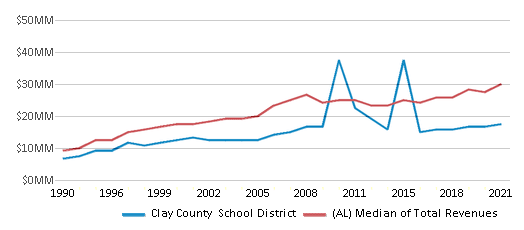
Spending
$20 MM
$9,086 MM
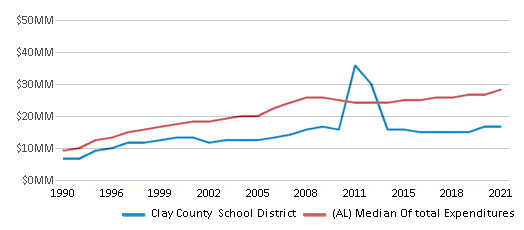
Revenue / Student
$11,788
$13,006
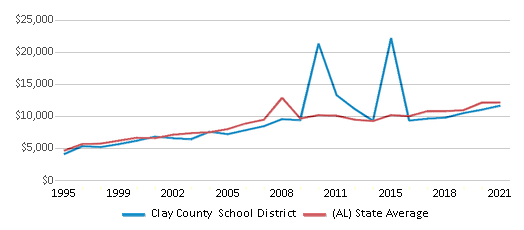
Spending / Student
$11,056
$12,220
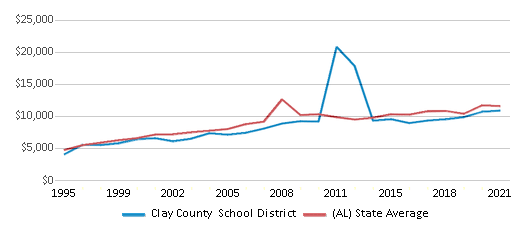
Best Clay County School District Public Middle Schools (2025)
School
(Math and Reading Proficiency)
(Math and Reading Proficiency)
Location
Grades
Students
Rank: #11.
Central Jr High School Of Clay County
(Math: 9% | Reading: 42%)
Rank:
Rank:
4/
Bottom 50%10
1 Bob Riley Drive
Lineville, AL 36266
(256) 396-1401
Lineville, AL 36266
(256) 396-1401
Grades: 7-8
| 284 students
Rank: n/an/a
Clay County Career Development Center
Vocational School
8177 Highway 9
Ashland, AL 36251
(256) 396-1475
Ashland, AL 36251
(256) 396-1475
Grades: 7-12
| n/a students
Recent Articles

What Is A Charter School?
Explore the world of charter schools in this comprehensive guide. Learn about their history, how they operate, and the pros and cons of this educational innovation. Discover key facts about charter schools, including admission policies, demographics, and funding, as well as what to look for when considering a charter school for your child.

10 Reasons Why High School Sports Benefit Students
Discover the 10 compelling reasons why high school sports are beneficial for students. This comprehensive article explores how athletics enhance academic performance, foster personal growth, and develop crucial life skills. From improved fitness and time management to leadership development and community representation, learn why participating in high school sports can be a game-changer for students' overall success and well-being.

February 05, 2025
Understanding the U.S. Department of Education: Structure, Impact, and EvolutionWe explore how the Department of Education shapes American education, from its cabinet-level leadership to its impact on millions of students, written for general audiences seeking clarity on this vital institution.





